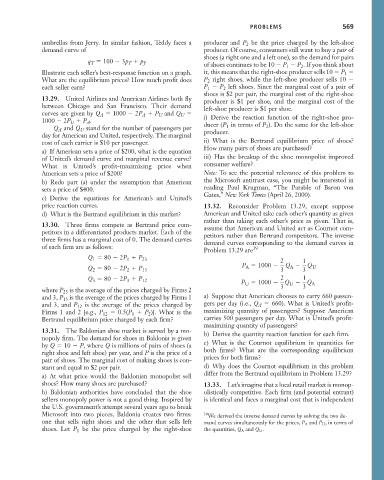Page 595 - Microeconomics, Fourth Edition
P. 595
c13marketstructureandcompetition.qxd 7/30/10 10:44 AM Page 569
PROBLEMS 569
umbrellas from Jerry. In similar fashion, Teddy faces a producer and P 2 be the price charged by the left-shoe
demand curve of producer. Of course, consumers still want to buy a pair of
shoes (a right one and a left one), so the demand for pairs
q T 100 3p T p J
of shoes continues to be 10 P 1 P 2 . If you think about
Illustrate each seller’s best-response function on a graph. it, this means that the right-shoe producer sells 10 P 1
What are the equilibrium prices? How much profit does P 2 right shoes, while the left-shoe producer sells 10
each seller earn? P 1 P 2 left shoes. Since the marginal cost of a pair of
shoes is $2 per pair, the marginal cost of the right-shoe
13.29. United Airlines and American Airlines both fly producer is $1 per shoe, and the marginal cost of the
between Chicago and San Francisco. Their demand left-shoe producer is $1 per shoe.
curves are given by Q A 1000 2P A P U and Q U
1000 2P U P A . i) Derive the reaction function of the right-shoe pro-
Q A and Q U stand for the number of passengers per ducer (P 1 in terms of P 2 ). Do the same for the left-shoe
day for American and United, respectively. The marginal producer.
cost of each carrier is $10 per passenger. ii) What is the Bertrand equilibrium price of shoes?
a) If American sets a price of $200, what is the equation How many pairs of shoes are purchased?
of United’s demand curve and marginal revenue curve? iii) Has the breakup of the shoe monopolist improved
What is United’s profit-maximizing price when consumer welfare?
American sets a price of $200? Note: To see the potential relevance of this problem to
b) Redo part (a) under the assumption that American the Microsoft antitrust case, you might be interested in
sets a price of $400. reading Paul Krugman, “The Parable of Baron von
c) Derive the equations for American’s and United’s Gates,” New York Times (April 26, 2000).
price reaction curves. 13.32. Reconsider Problem 13.29, except suppose
d) What is the Bertrand equilibrium in this market? American and United take each other’s quantity as given
rather than taking each other’s price as given. That is,
13.30. Three firms compete as Bertrand price com- assume that American and United act as Cournot com-
petitors in a differentiated products market. Each of the petitors rather than Bertrand competitors. The inverse
three firms has a marginal cost of 0. The demand curves demand curves corresponding to the demand curves in
of each firm are as follows: 39
Problem 13.29 are
Q 1 80 2P 1 P 23 2 1
P A 1000 Q A Q U
Q 2 80 2P 2 P 13 3 3
2 1
Q 3 80 2P 3 P 12
P U 1000 Q U Q A
where P 23 is the average of the prices charged by Firms 2 3 3
and 3, P 13 is the average of the prices charged by Firms 1 a) Suppose that American chooses to carry 660 passen-
and 3, and P 12 is the average of the prices charged by gers per day (i.e., Q A 660). What is United’s profit-
Firms 1 and 2 [e.g., P 12 0.5(P 1 P 2 )]. What is the maximizing quantity of passengers? Suppose American
Bertrand equilibrium price charged by each firm? carries 500 passengers per day. What is United’s profit-
maximizing quantity of passengers?
13.31. The Baldonian shoe market is served by a mo- b) Derive the quantity reaction function for each firm.
nopoly firm. The demand for shoes in Baldonia is given
by Q 10 P, where Q is millions of pairs of shoes (a c) What is the Cournot equilibrium in quantities for
right shoe and left shoe) per year, and P is the price of a both firms? What are the corresponding equilibrium
pair of shoes. The marginal cost of making shoes is con- prices for both firms?
stant and equal to $2 per pair. d) Why does the Cournot equilibrium in this problem
differ from the Bertrand equilibrium in Problem 13.29?
a) At what price would the Baldonian monopolist sell
shoes? How many shoes are purchased? 13.33. Let’s imagine that a local retail market is monop-
b) Baldonian authorities have concluded that the shoe olistically competitive. Each firm (and potential entrant)
sellers monopoly power is not a good thing. Inspired by is identical and faces a marginal cost that is independent
the U.S. government’s attempt several years ago to break
Microsoft into two pieces, Baldonia creates two firms: 39 We derived the inverse demand curves by solving the two de-
one that sells right shoes and the other that sells left mand curves simultaneously for the prices, P A and P U , in terms of
shoes. Let P 1 be the price charged by the right-shoe the quantities, Q A and Q U .

